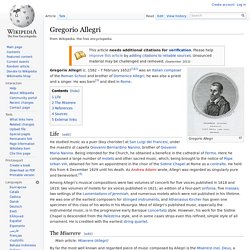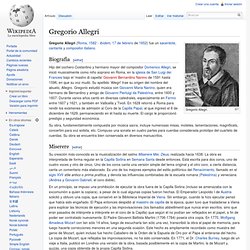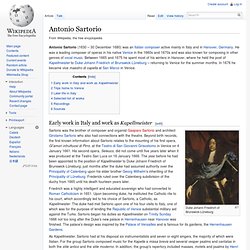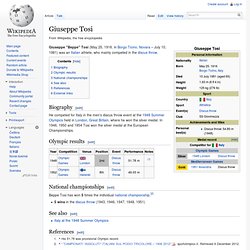

Gregorio Allegri. Gregorio Allegri (c. 1582 – 7 February 1652)[1][2] was an Italian composer of the Roman School and brother of Domenico Allegri; he was also a priest and a singer.

He was born[3] and died in Rome. Life[edit] He studied music as a puer (boy chorister) at San Luigi dei Francesi, under the maestro di capella Giovanni Bernardino Nanino, brother of Giovanni Maria Nanino. Being intended for the Church, he obtained a benefice in the cathedral of Fermo. Here he composed a large number of motets and other sacred music, which, being brought to the notice of Pope Urban VIII, obtained for him an appointment in the choir of the Sistine Chapel at Rome as a contralto.
The Miserere[edit] The Miserere is one of the most often-recorded examples of late Renaissance music, although it was actually written during the chronological confines of the Baroque era; in this regard it is representative of the music of the Roman School of composers, who were stylistically conservative. Mantua. Canal en Mantua Mantua (en italiano: Mantova), capital de la provincia homónima, es una ciudad italiana que se encuentra en la región de Lombardía.

Está rodeada en tres de sus lados por el río Mincio. Gregorio Allegri. Gregorio Allegri.

FILIPPO VITALI - Search results. Jan Dismas Zelenka. Life[edit] Zelenka was born in Launiowitz, a small market town southeast of Prague, in Bohemia. the eldest of the eight children born to Marie Magdalena (née Hájek) and Jiří Zelenka.

The middle name Dismas is probably his confirmation name.[2] His father was a schoolmaster and organist there; nothing more is known with certainty about Zelenka's early years. Francesco Maria Veracini. Francesco Maria Veracini.

Francesco maria benedetti - Search results. The Four Seasons (Vivaldi) Manierismo. El manierismo[1] es un estilo artístico que predominó en Italia desde el final del Alto Renacimiento (c. 1530) hasta los comienzos del período Barroco, aproximadamente hacia el año 1600.

El manierismo se originó en Venecia gracias a los mercaderes y, en Roma, gracias a los papas Julio II y León X, pero finalmente se extendió hasta España, Europa central y Europa del norte. Se trataba de una reacción anticlásica que cuestionaba la validez del ideal de belleza defendido en el Alto Renacimiento. El manierismo se preocupaba por solucionar problemas artísticos intrincados, como desnudos retratados en posturas complicadas. Antonio Sartorio. Antonio Sartorio (1630 – 30 December 1680) was an Italian composer active mainly in Italy and in Hanover, Germany.

He was a leading composer of operas in his native Venice in the 1660s and 1670s and was also known for composing in other genres of vocal music. Between 1665 and 1675 he spent most of his winters in Hanover, where he held the post of Kapellmeister to Duke Johann Friedrich of Brunswick-Lüneburg – returning to Venice for the summer months. In 1676 he became vice maestro di capella at San Marco in Venice. Early work in Italy and work as Kapellmeister[edit] Duke Johann Friedrich of Brunswick-Lüneburg Sartorio was the brother of composer and organist Gasparo Sartorio and architect Girolamo Sartorio who also had connections with the theatre. Tomaso Albinoni. Tomaso Albinoni Tomaso Giovanni Albinoni (8 June 1671 – 17 January 1751) was an Italian Baroque composer.

While famous in his day as an opera composer, he is mainly remembered today for his instrumental music, such as the concertos, some of which are regularly recorded.[1] Benedetto Ferrari. Il Giardino Armonico. Il Giardino Armonico in the Kraków Philharmonic during the Misteria Paschalia Festival, April 2010 Il Giardino Armonico ("The Harmonious Garden") is a pioneering Italian early music ensemble founded in Milan in 1985 by Luca Pianca and Giovanni Antonini, primarily to play 17th- and 18th-century music on period instruments.

Il Giardino Armonico performs with soloists such as the mezzosoprano Cecilia Bartoli, duo pianists Katia and Marielle Labèque, cellist Christophe Coin, and soprano Danielle de Niese. Its recordings have met with honors including the Gramophone and Grammy Awards. Giuseppe Tosi. Giuseppe "Beppe" Tosi (May 25, 1916, in Borgo Ticino, Novara – July 10, 1981) was an Italian athlete, who mainly competed in the discus throw.

Biography[edit] He competed for Italy in the men's discus throw event at the 1948 Summer Olympics held in London, Great Britain, where he won the silver medal. In 1946, 1950 and 1954 Tosi won the silver medal at the European Championships. Pietro Locatelli. Pietro Locatelli ca. 1733Mezzotinto by Cornelis Troost (1696–1750) Pietro Antonio Locatelli (born 3 September 1695 in Bergamo; died 30 March 1764 in Amsterdam) was an Italian Baroque composer and violinist. Biography[edit] Bergamo[edit] Little is known about Locatelli's childhood. Violin.
A young violinist The violin is sometimes informally called a fiddle, regardless of the type of music played on it. The word violin comes from the Medieval Latin word vitula, meaning stringed instrument;[1] this word is also believed to be the source of the Germanic "fiddle".[2] The violin, while it has ancient origins, acquired most of its modern characteristics in 16th-century Italy, with some further modifications occurring in the 18th and 19th centuries.
Violinists and collectors particularly prize the instruments made by the Gasparo da Salò, Giovanni Paolo Maggini, Stradivari, Guarneri and Amati families from the 16th to the 18th century in Brescia and Cremona and by Jacob Stainer in Austria. A person who makes or repairs violins is called a luthier. Piero della Francesca. Arcangelo Corelli. Arcangelo Corelli Arcangelo Corelli (17 February 1653 – 8 January 1713) was an Italian violinist and composer of the Baroque era. Giuseppe Torelli. Giuseppe Torelli. Giuseppe Torelli (22 April 1658 – 8 February 1709) was an Italian violist, violinist, teacher, and composer. Torelli is most remembered for his contributions to the development of the instrumental concerto (Newman 1972, p. 142), especially concerti grossi and the solo concerto, for strings and continuo, as well as being the most prolific Baroque composer for trumpets (Tarr 1974).
Jacopo Peri. Gravestone in Santa Maria Novella In the 1590s, Peri became associated with Jacopo Corsi, the leading patron of music in Florence. They believed contemporary art was inferior to classical Greek and Roman works, and decided to attempt to recreate Greek tragedy, as they understood it. Their work added to that of the Florentine Camerata of the previous decade, which produced the first experiments in monody, the solo song style over continuo bass which eventually developed into recitative and aria. Ignacio de Jerusalem y Stella. Carlo Pallavicino. Carlo Pallavicino (Pallavicini) (ca. 1630 – 29 January 1688) was an Italian composer. Pallavicino was born at Salò, Italy. From 1666 to 1673, he worked at the Dresden court; from 1674 to 1685, at the Ospedale degli Incurabili (a conservatory where orphaned children were musically trained) in Venice and further in Dresden. In August and September 1687, he was with the concert master Georg Gottfried Backstroh back in Venice.
Giovan Battista Langetti. Giovan Battista Langetti, The Suicide of Catão Giovanni Battista Langetti (1625–1676), also known as Giambattista Langetti, was an Italian late-Baroque painter. He was active in his native Genoa, then Rome, and finally for the longest period in Venice. He first trained with Assereto, then Pietro da Cortona, but afterwards studied under Giovanni Francesco Cassana, appeared in Venice by 1650s where he worked in a striking Caravaggesque style. He is thought to have influenced Johann Karl Loth and Antonio Zanchi. Giacinto Gimignani. Venus appears to Aeneas and Achates Angel and Devil fight for soul of child. Giacomo Carissimi. Giacomo Carissimi. Falsobordone. Unlike the etymologically related but largely dissimilar fauxbourdon, falsobordoni have all four vocal parts written out and chiefly use root position triads as opposed to first inversion triads.
Julian Beever. Julian Beever (1959, Cheltenham, Reino Unido)[1] es un artista británico que se dedica a dibujar con tiza. Ha creado dibujos de tiza en 3D en el pavimento utilizando un método llamado anamorfosis que crea una ilusión óptica. Sus dibujos en las calles desafían las leyes de la perspectiva. Ha logrado una técnica que le da un gran realismo a la imagen. La particularidad de este artista es que dibuja en la calle utilizando gises de colores; sus diseños han sido captados en fotos vídeos ya que, al ser este un arte que se realiza a la intemperie , el paso de los peatones o la lluvia terminan por borrar la obra original. Julian Beever. Cat fugue. The Fugue in G minor (K. 30, L. 499) by Domenico Scarlatti is a one-movement harpsichord sonata popularly known as the Cat fugue or Cat's fugue (La Fuga del Gatto). History of the nickname[edit]
Nuevos enfoques sobre el barroco y la (posmodernidad: a propósito de dos estudios de fernando r. de la flor. Giuseppe Tartini. Adriano Palladino. Home. FRANCESCO MARIA BAZZINO - Search results. Massimiliano Neri. Giovanni Battista Natali. Antonio Cesti. Biagio Marini. Venetian School. Livio Mehus. Caravaggio. Giovanni Maria Bottala. Giovanni Battista Vitali. Category:Mannerist paintings.